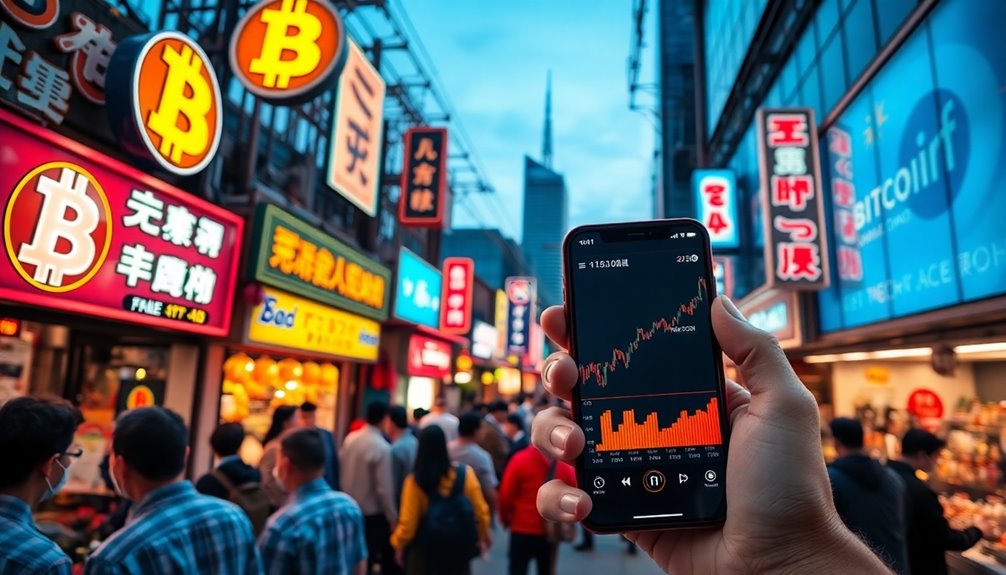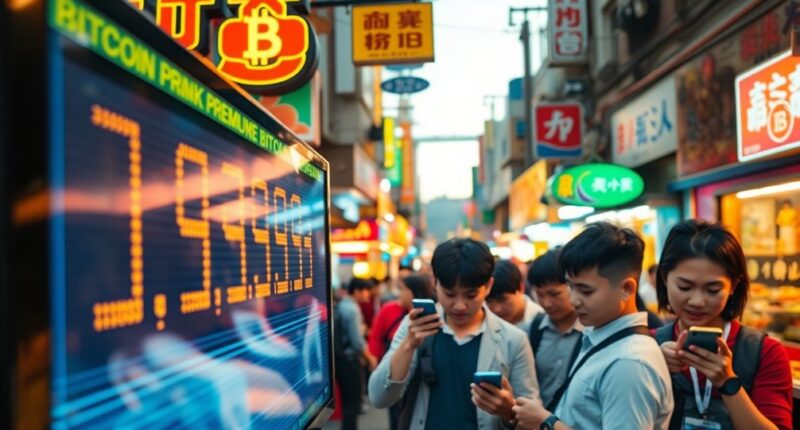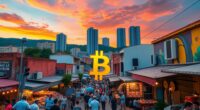Bitcoin's Kimchi Premium has surged to a three-year high of 12%, showcasing significant price differences between South Korea and international exchanges. This spike isn't due to increased Korean buyer interest but arises from a strong US dollar and ongoing economic concerns. As traders notice these market inefficiencies, local regulations and global economic factors play a key role in shaping the trading landscape. Stick around to discover how these elements influence your trading decisions.
Key Takeaways
- The Kimchi Premium refers to the price difference of Bitcoin between South Korean and international exchanges, recently peaking at 12%.
- This surge to a three-year high coincided with significant market downturns and economic concerns, reflecting market inefficiencies.
- The rise in Kimchi Premium was not due to increased demand from Korean buyers but rather influenced by global economic factors.
- Koreans are increasingly preferring to convert Bitcoin to USD instead of Korean won, indicating broader economic uncertainty.
- Global economic instability and trade tensions have significant implications for Bitcoin price movements and trading strategies in South Korea.

As the cryptocurrency market fluctuates, you've likely heard about the Kimchi Premium, a term that describes the price difference between Bitcoin on South Korean exchanges and those internationally. Originating from South Korea's beloved dish, kimchi, this phenomenon first appeared in early 2016 and reached an astonishing peak of 54.48% in January 2018.
The premium arises from distinct market dynamics where traders exploit the price gap. They buy Bitcoin on international exchanges at lower prices and sell it on South Korean exchanges for a profit, capitalizing on the disparity.
Recently, Bitcoin's Kimchi Premium surged to a three-year high of 12%, coinciding with significant market downturns. This spike occurs during a time of economic concerns, rather than a surge in demand from Korean buyers. Factors like a strong US dollar and rising trade tensions are influencing this situation. The Kimchi Premium reached 12% during a period where panic-selling in overseas markets was prevalent, illustrating the disconnect between local and international trading behaviors.
Interestingly, fewer Koreans are converting Bitcoin to Korean won these days; instead, many are opting to convert it to USD. This trend reflects broader economic uncertainty, showcasing the appeal of the US dollar as a safe-haven asset. Decentralized finance (DeFi) applications are also attracting attention in South Korea, indicating a shifting focus within the crypto space.
The Kimchi Premium serves as a reminder of the inefficiencies in the global cryptocurrency market. By highlighting price disparities across markets, it presents opportunities for traders, but also comes with risks. Market volatility and exchange restrictions can complicate the arbitrage process.
Local regulations might further impact your ability to take advantage of these price differences, making it crucial to stay informed.
Trade tensions, particularly US tariffs on various countries, have also played a role in shaping the crypto landscape. As the global economy faces instability, many investors gravitate toward safe-haven assets like the US dollar.
The future trajectory of Bitcoin's price hinges on reclaiming key levels and resolving ongoing global economic uncertainties. In this complex environment, understanding the Kimchi Premium could lead to strategic trading decisions.
Conclusion
As you watch the sun dip below the horizon, painting the sky with hues of gold and crimson, the allure of Bitcoin's Kimchi Premium becomes crystal clear. South Korea's fervent trading activity pulses like a heartbeat, driving prices to dizzying heights. This surge isn't just numbers on a screen; it's a vibrant tapestry woven from ambition and innovation. Embrace this moment, for the waves of change in the crypto sea are only just beginning to swell.









